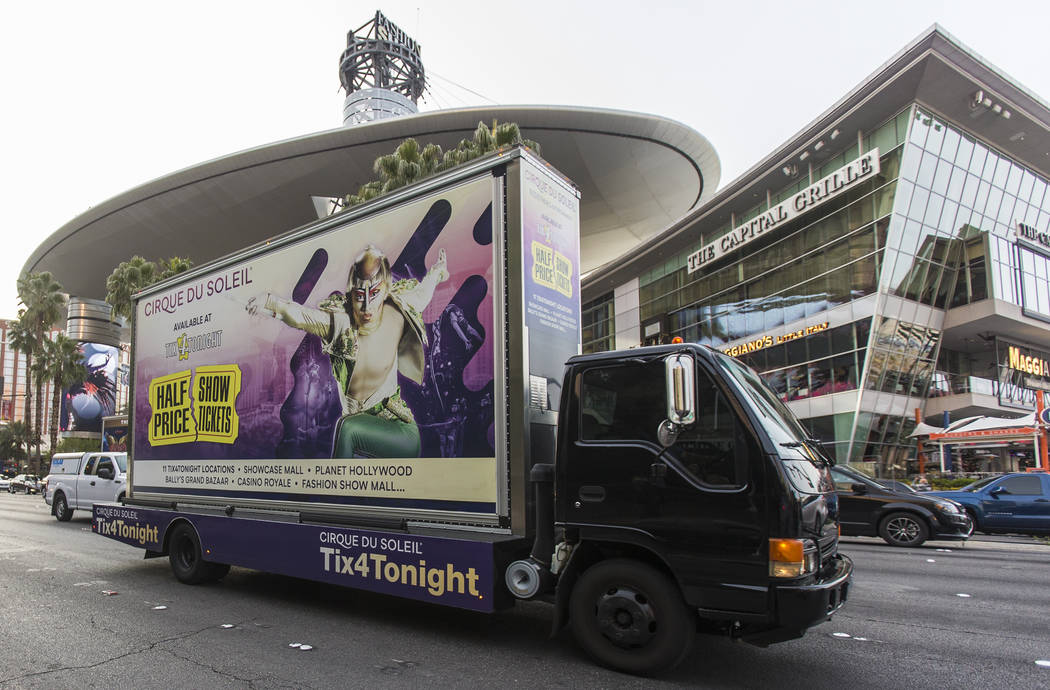Clark County adopts mobile billboard rules on Las Vegas Strip
The Clark County Commission on Tuesday adopted rules for mobile billboards that are primarily seen cruising on the Las Vegas Strip, formalizing what some have called the first comprehensive industry regulations in the U.S.
The rules don’t affect the messages that appear on the billboards. They regulate things such as licenses, how the billboards operate in traffic and where they can be stored.
County officials now expect a rush of operators seeking to license their vehicles after Jan. 1, when the new ordinance is slated to take effect.
“We take very seriously the fact that this is the first of its kind,” said Commissioner Jim Gibson, who spearheaded the effort. “This is the gold standard, but we’re not finished with it.”
Officials view the ordinance as a good start to creating so-called rules of the road, regulating the safety, size and brightness of the advertising. However, it will not address the sometimes-risqué content of mobile billboards.
Beyond setting a countywide standard, the rules provide officials with a tool to track the industry’s footprint in Southern Nevada. Though officials believe the number of mobile billboards on the Strip has risen in recent years, there is no way to measure that.
“Quite honestly, we’re not really sure how many there are out there already, and we need to discover that,” Gibson said.
As operators obtain required licenses with a $500 fee per vehicle, and decals that must be displayed on the rear bumper, Gibson and others say officials will have their first accurate sense of the industry’s size. Mobile billboard operators who have publicly addressed the ordinance have been supportive.
The ordinance does not regulate how many vehicles may be licensed, despite a call by the Nevada Resort Association to set limits on the number. Gibson said officials plan to closely study the effect of the new rules on traffic in the resort corridor before revisiting any potential new restrictions.
Ultimately, the ordinance is intended to ensure public safety, he said.
It creates a new chapter in county code outlining a lengthy list of rules for operators, including requirements they register vehicles in the state; ensure drivers have valid Nevada driver’s licenses and appropriate training; and submit an annual report detailing any citations received by operators.
Also, the ordinance implements restrictions on activity: no detachable trailer-drawn billboards; no purposefully impeding traffic; no U-turns; no operating in winds over 35 mph; and no parking or storing on a residential street within 500 feet of any home, school or community facility.
The billboards themselves are subject to rules including limits on brightness and a ban on flashing lights or animation that might distract motorists. (The exception is if the advertisement is only visible on the passenger side, the vehicle is driven in the right travel lane and is equipped with a system to automatically shut off the display when outside what is generally considered the Strip.)
Jacqueline Holloway, director of the county’s Department of Business License, said there will be a dedicated hotline to report complaints and that officials might conduct a workshop with operators before Jan. 1 so they understand expectations.
Gibson said the county and mobile billboard operators had a responsibility to work together.
“The better this ordinance works, and the better the outcome,” he said, “the less likely it is that more onerous regulation will come forward in the future.”
Contact Shea Johnson at sjohnson@reviewjournal.com or 702-383-0272. Follow @Shea_LVRJ on Twitter.





























